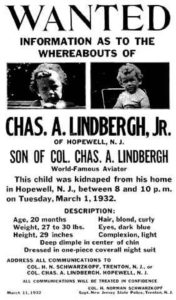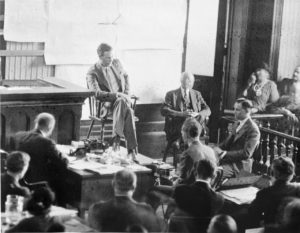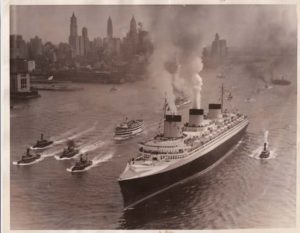 When the French luxury liner Normandie was launched in 1935 it was the fastest and most powerful ship of its kind, setting a transatlantic record of 4 days, three hours on its maiden voyage from Le Harve France to New York. The ship also carried a special cargo for Calais Maine but more on that later. A more powerful liner was never built although by 1952 faster liners such as the American Blue Riband eventually took almost a day off the Normandie’s record. The Normandie made 139 transatlantic crossing before being seized by the U.S. Government during the Second World War. She was in the process of being converted into a troop ship when she caught fire and sank in New York Harbor. Finally raised after the war the Normandie was too badly damaged to be repaired and was scrapped. Most other international news of 1935 featured the dictators Hitler and Mussolini. Hitler began to openly rearm in violation of the Versailles Treaty and deprived Germans Jews of their citizenship with the notorious Nuremberg laws while Mussolini invaded a nearly helpless Abyssinia, now Ethiopia, in what was to prove his only successful military campaign.
When the French luxury liner Normandie was launched in 1935 it was the fastest and most powerful ship of its kind, setting a transatlantic record of 4 days, three hours on its maiden voyage from Le Harve France to New York. The ship also carried a special cargo for Calais Maine but more on that later. A more powerful liner was never built although by 1952 faster liners such as the American Blue Riband eventually took almost a day off the Normandie’s record. The Normandie made 139 transatlantic crossing before being seized by the U.S. Government during the Second World War. She was in the process of being converted into a troop ship when she caught fire and sank in New York Harbor. Finally raised after the war the Normandie was too badly damaged to be repaired and was scrapped. Most other international news of 1935 featured the dictators Hitler and Mussolini. Hitler began to openly rearm in violation of the Versailles Treaty and deprived Germans Jews of their citizenship with the notorious Nuremberg laws while Mussolini invaded a nearly helpless Abyssinia, now Ethiopia, in what was to prove his only successful military campaign.
In the United States the country was riveted when Bruno Hauptmann went on trial for the kidnapping of the Lindbergh baby.The photo above shows Charles Lindbergh testifying at the 1935 trial. The tragic drama had played out for nearly three years before Hauptman’s trial began on January 2, 1935. He had been charged with the crime only in September of 1934 after years of false leads, appeals to the public for information and questionable police work. A ransom had been paid in April 1932 before the boy’s body was discovered in May and Hauptmann was found in possession of some the ransom money in 1934. The evidence of his connection with the actual murder was largely circumstantial and Hauptmann denied his guilt to the end which came on the electric chair April 3, 1936. Before his execution he was offered a reduction of his sentence to life imprisonment if he confessed but he refused this offer, maintaining his innocence.
In other U.S. news Amelia Earhart flew solo from Honolulu to Oakland California, Roosevelt’s WPA legislation was approved by Congress but much of the National Recovery Act was ruled unconstitutional by the Supreme Court setting up a conflict between the two branches of government which culminated in Roosevelt’s unwise and unsuccessful attempt to pack the Court. Alcoholics Anonymous got its start, the Hoover Dam was dedicated and Huey Long, the maverick from Louisiana, held the floor of the Senate for 15 ½ hours in the longest speech in Senate history. In sports Gene Saracen won the Masters with the help of a double eagle at the end of the last round, Roller Derby was introduced to the sporting public and brothers Tony and Al Cuccunello homered in the same game playing for opposing teams. Bob Hope debuted on radio, Monopoly went on the market, Penquin published its first book and Irene Curie, daughter of Marie Curie, won the Nobel Prize for her work on artificial radiation. In odd news, a Russian set the record, unbroken as far as we know to this day, by digging 105 tons of cabbage in 6 hours. Finally a clothing company called Cooper Inc marketed the first men’s briefs, they were called jockeys.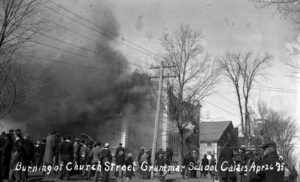 1935 saw the loss of two of Calais’ finest old buildings. On May 1st, 1935 the grammar school on Academy Street caught fire early in the morning. The fire department arrived in time to possibly save the building but the water pressure on the hill was poor and the wind was blowing strongly. The best the firemen could do was save the adjacent houses by standing on their roofs with hoses. Several firemen were burned. According to the Advertiser “ As the cupola which housed the bell burned it could be seen to slip down on one side and a single stroke just before the cupola fell seemed to give warning that it was leaving its perch of many years to start its decent to the basement, and it would never again call the children to school.”
1935 saw the loss of two of Calais’ finest old buildings. On May 1st, 1935 the grammar school on Academy Street caught fire early in the morning. The fire department arrived in time to possibly save the building but the water pressure on the hill was poor and the wind was blowing strongly. The best the firemen could do was save the adjacent houses by standing on their roofs with hoses. Several firemen were burned. According to the Advertiser “ As the cupola which housed the bell burned it could be seen to slip down on one side and a single stroke just before the cupola fell seemed to give warning that it was leaving its perch of many years to start its decent to the basement, and it would never again call the children to school.”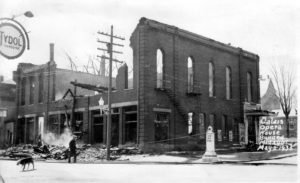
A week later Calais’ famous Opera House suffered the same fate. Again the firemen were compelled to try to save the surrounding buildings. The Advertiser reports “It became apparent that to prevent a general conflagration that the firemen must concentrate on nearby buildings. Too much credit cannot be given the firemen for their fine work in saving the MacCloud House and the Emmans Hotel, for if either had been neglected it is hard to say what the end might have been. Water was poured on both houses but the heat was so intense that the paint on the MacCloud House next to the burning building was blistered and more than 50 panes of glass broken. The plate glass all along the front of the Emmans Hotel was also cracked. Down the street the roofs of the Methodist Church and the home of MA Brogan caught but were extinguished.” The Opera House was rebuilt and was most recently the JD Thomas office building. The MacCloud House was Ken Collins Rooming House. The Brogan House is now the food pantry which gives some idea how intense this fire was.
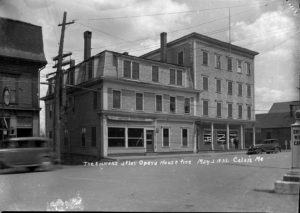 ...and this was the Emmans Hotel, windows cracked, after the fire. The Emmans was demolished in 1939 and became the JD Thomas gas station.
...and this was the Emmans Hotel, windows cracked, after the fire. The Emmans was demolished in 1939 and became the JD Thomas gas station.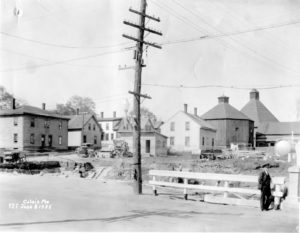 1935 saw the beginning of construction of the new Customs House at the Ferry Point Bridge. In this photo it is still just the hole in the foreground. To the rear are the old gas works with the two octagon buildings, and the long building behind them. Frank Damon grew up in the shadow of these buildings, and remembered all about them. Frank says these two buildings were built on cement cellars which were full of water, and that steel storage tanks were set in the water which would rise and fall according to the amount of gas in the tanks. The long building is what he called the ‘Tori ‘shed, and contained the furnace where the coal was fired. The coal was shipped in by vessel and unloaded at the wharf, behind the Eastern Pulpwood Co. building. It was hauled up the hill by horse-pulled dump wagons and dumped into coal sheds along the bank of the river. The coal was burned into coke and the tar and gas was produced. They sold the tar in drums, and bagged the coke, and, from the late 1860’s, the gas was piped through the streets and into the houses. Some of the old houses in Calais still have the gas pipes and an occasional gas fixture.
1935 saw the beginning of construction of the new Customs House at the Ferry Point Bridge. In this photo it is still just the hole in the foreground. To the rear are the old gas works with the two octagon buildings, and the long building behind them. Frank Damon grew up in the shadow of these buildings, and remembered all about them. Frank says these two buildings were built on cement cellars which were full of water, and that steel storage tanks were set in the water which would rise and fall according to the amount of gas in the tanks. The long building is what he called the ‘Tori ‘shed, and contained the furnace where the coal was fired. The coal was shipped in by vessel and unloaded at the wharf, behind the Eastern Pulpwood Co. building. It was hauled up the hill by horse-pulled dump wagons and dumped into coal sheds along the bank of the river. The coal was burned into coke and the tar and gas was produced. They sold the tar in drums, and bagged the coke, and, from the late 1860’s, the gas was piped through the streets and into the houses. Some of the old houses in Calais still have the gas pipes and an occasional gas fixture.
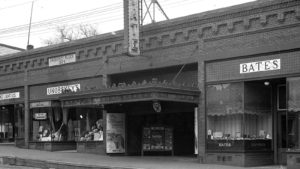 The old State Theatre was showing Helen Hayes and Robert Montgomery in “Vanessa” Her Love Story in this 1935 photo. 1935 was also the year the matriarch of the Unobskey family, Sarah Unobskey died suddenly of a heart attack. It was a great loss to the community as her vision and determination were responsible for many of Calais’ fine brick blocks, including the State Theatre block.
The old State Theatre was showing Helen Hayes and Robert Montgomery in “Vanessa” Her Love Story in this 1935 photo. 1935 was also the year the matriarch of the Unobskey family, Sarah Unobskey died suddenly of a heart attack. It was a great loss to the community as her vision and determination were responsible for many of Calais’ fine brick blocks, including the State Theatre block.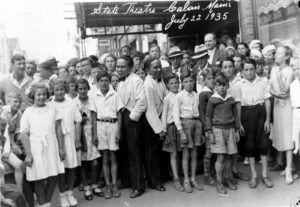
This is another 1935 photo taken in front of the State Theatre and it’s all about twins. The two well dressed fellows in the middle of the picture are Siamese twins, the famous Godino Twins, Simplicio and Lucio, from the Philippines. Naturally there a story behind the photo. According to Sidney Unobskey his father Arthur was always looking for ways to get people downtown. In 1935 vaudeville was still a popular entertainment and the Godino Brothers were big attractions. Arthur Unobskey brought them to Calais for a two day stint at the State Theatre. His father put an ad in the papers inviting all St Croix Valley twins to attend free and meet the Godinos. There were a lot of them in the area at the time: Twin boys- Rutherfords, Kellys, Bassetts, Pikes, Wheelers, Wallaces and Wrigleys. Twin girls- Murphys, Chaffees, Holms and Gartleys and TheMcKay brother and sister. In the photo we have identified, left to right Winnie and Pat Murphy, David and Davida McKay, the Godinos, Donald and Douglas Rutherford, perhaps the Kelley boys, Donnie and his brother and John Bassett wearing a white shirt and short black pants with his brother George to his left rear. These are not positive ID’s but the best guess we can make from memories 75 years old. Some of the other twins may be in the crowd behind. Bill Gordon actually recalls going to the performance. He remembers the Godinas rollerskating on the stage of the State Theatre. The Godinos were from the Philippines. They married identical twins after initially being denied a marriage license because the municipal clerk took the position they were one person and therefore couldn’t marry two women. They played golf and even drove a car. On one occasion Lucio ran into another vehicle while drunk but successfully argued he couldn’t serve the 5 day sentence imposed by the judge as it would be unfair to Simplicio. The Godino’s were very successful on the vaudeville circuit as both were excellent dancers and roller skaters. Their wives were equally talented and were easily incorporated into the act. Sadly the Godino brothers lived for only a year after their performance at the State Theatre. Lucio caught pneumonia in the fall of 1936 and died in November. An emergency operation separated Simplicio from his brother but he too died twelve days later. There is a dispute about the “Rigley” twins. Some say Bernard and John were twins and other say it wasn’t so. 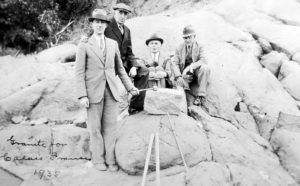
Above I mentioned that the liner Normandie carried a cargo in 1935 for Calais on her maiden voyage. I’ll let our famous historian H E Lamb tell you the rest of the story:
By H. E. Lamb from Calais Advertiser 1954
From Calais to Calais
The early thirties of this century saw a rivalry between nations of Europe for the title of The Queen of the Seas. The English bid for the title was the Queen Mary, Italy also had one, but the French based their hopes on the Normandy. Which of these beautiful liners was the largest depended somewhat on how it was measured. A great excitement was created when one of these ships left Europe for New York. Calais was of course interested, never dreaming that she would be more intimately connected with any of the these leviathans of the deep. When the Normandy was docked in New York, Mayor Clarence Beckett received word that she had carried in her hold a box containing gifts from the City of Calais, France to her namesake, Calais, Maine U. S. A. The Franco-American Society arranged the gesture to celebrate the maiden voyage of the Normandy and to cement the friendship between the two countries.
When the box was received and opened it contained, as the chief item a beautiful hand carved mahogany casket, with shields on the front in the French colors, and on the top was a heavy gold and enamel coat of arms of the City of Calais, France. The interior was lined with copper and the Mayor of the City and other dignities had gone in their full dress suits to the oldest cemetery in the city and filled the casket with earth from the oldest grave.
Calais, France, was noted for the manufacturing of beautiful laces and more than a dozen firms had sent bolts of their products to the city across the sea. One piece was a wonder overdress ready to be put over a foundation. Then there were 2 large volumes of history of the city and a heavy volume of photographs of the city, with a duplicate seal on the casket.
These gifts can be seen in the Calais Free Library and reading room. The case which holds the casket and the laces was made possible by a gift from Mrs. William J. Fowler, wife of the former mayor of the city who had been elected to that office more times than any other mayor.
At once plans were made to send some gifts back to the city whose name we bear. Meetings were held and it was decided that the most suitable thing would be a tablet of granite from St. Croix Island. So an expedition went down to the island to find a suitable stone . There was the Mayor, Clarence Beckett, Mr. Phelan, who knew stone work and would finish the tablet, John Trimble and the writer. We were sorry to leave Roy Ryan on the Red Beach shore but the boat that Captain Small of the Lighthouse brought over was too small to hold more. A small boulder was found on the sand on the lower end of the island, which, when it was cracked open, Mr. Phelan pronounced suitable. The stone was cut and polished and a bronze tablet fastened on the top which read:
Granite From
St. Croix Island
Calais, Maine. U. S. A.
Site of
De Monts and Champlain
Settlement 1604
From Calais, Maine to Calais, France 1935
A base and basket work cover in the French colors was woven by Rose Neptune of Calais and a member of thePassamaquoddy tribe, who was nearly one hundred years old. A leather covered album of three dozen views of this city was prepared, and a sketch of the city as requested by the French city. A plaque holding pieces of wood native here was made by school children.
Major Justin Hannigan of Boston and representative of the French Council at New York and Franco-American Society which had arranged the exchange, came from Boston and in a largely attended meeting to the State Theatre on Friday. Nov. 1, 1935, presided over In Dr. Miner. Major Hannigan presented the gifts to this city and received the gifts of this city from Mayor Beckett. In the evening a large banquet was held in the vestry of the Baptist church, where Major Hannigan, Hon. Lewis O. Barrows (afterwards Governor of Maine) representative for Governor Brann and H. E. Lamb were the speakers.
The following March the mayor of Calais, France, M. Vadez surrounded by many noted men of the city and representatives of the U. S. and the Franco-American Society received the gifts prepared so far across the sea. They were deposited in their library and where we hope they still are in spite of the storm of war. But we have one thought. There is one bit of the soil of France that the Germans did not get.
During the war Major Hannigan returned to France the decorations that France had given him in protest against the conditions in that country at that time.
The later story of the Normandy is tragic. Docked in New York harbor, she was sunk twice through carelessness, at least, that is the big black mark against the United States. Her hull has been raised and sold for junk for a few thousand dollars, whereas she had cost millions.
In other local news of 1935 the Federal Government began acquiring land in Baring for the Moosehorn Wildlife Refuge, on Pleasant Lake in Alexander there was but one camp owned by Mr and Mrs B. Jones of Baileyville, Dot Andrews and Barry Burns were married and Clarence Beckett was the Mayor of Calais. There was a big crackdown on illegal liquor sales in the area, 143 arrest warrants were issued and the Calais Municipal Court was running late into the night. One Calais man was charged not only with illegal sales but arson as “He is alleged to have poured a quantity of alcohol on the floor of his home and attempted to set fire to it when the deputy visited his establishment.”
It was reported in the Advertiser that Calais Police Chief Bobby Kerr had gone beyond the call of duty to recover $80.00 lost by Lindsey Jacobs to gypsies:
“Speaking of the law and the dedication of our public servants, a special commendation should have been awarded to Bobby Kerr, City Marshall, for his work on the Lindsay Jacobs robbery in November of 1935. Lindsay was apparently bilked or robbed of some $80.00 by a band of gypsies near Robbinston and Bobby, following what the Advertiser describes as a “slim clue”, traced the desperadoes all the way to Bangor where they had set up a temporary fortune telling shop. He returned home with the $80.00 but without the gypsies.”
A group of Milltown men were taken into custody for yarding off a good part of the inventory of JC Penney on Main Street in a daring late night break in. According to the paper even the manager couldn’t say for sure what these fellows had gotten away with and the police suspected much was still stashed on “Corliss’ Hill” in Milltown, wherever that may be.
Finally in early August Eleanor Roosevelt had taken up residence on Campobello and came to Calais to attend church services one Sunday at the St Anne’s Episcopal Church.

